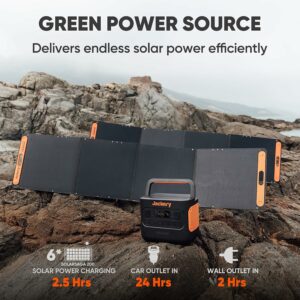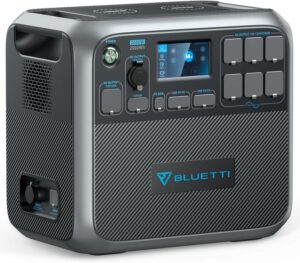Knowing How A Solar Generator Works
Introduction to Solar Generators
In recent years, the global focus on sustainable and eco-friendly energy solutions has led to a surge in interest in renewable energy sources.
Among these, solar power is a clean and abundant energy source.
Solar generators, in particular, have gained popularity as practical and versatile devices harnessing the sun’s power.
Solar energy, derived from the sun’s rays, is harnessed through advanced technologies like photovoltaic cells.
Unlike traditional fossil fuels, solar power is abundant, inexhaustible, and produces minimal environmental impact.
Provo Green Products embodies a beacon of trust in sustainable discoveries, offering choices that enhance your life and leave a positive mark on our planet.
Leveraging extensive expertise in manufacturing, construction, and various trades, we provide a solid foundation for sustainable living.
Our meticulous research process guarantees that our information about each product is precise and current, allowing you to make informed decisions.
Whether your interest lies in solar products, electric bikes, or other eco-friendly alternatives, our commitment to credibility ensures you have access to dependable insights, guiding your journey toward a more sustainable lifestyle.
Provo Green Products is your go-to destination for finding the right green products for your lifestyle.
Disclosure: As an Amazon Associate, we may earn from qualifying purchases. This does not affect the product pricing whatsoever.
Importance of Solar Generators
As traditional energy sources face challenges such as depletion and environmental concerns, the importance of embracing alternative energy solutions becomes evident.
Solar generators play a crucial role in this transition, offering a reliable and efficient way to generate electricity without relying on non-renewable resources.
Solar generators are not only environmentally friendly but also contribute to energy independence.
By harnessing sunlight to produce electricity, users can reduce their dependence on conventional power grids, especially in areas where access to electricity is limited or unreliable.
This makes solar generators a viable solution for both urban and remote settings.
Brief Explanation of How Solar Generators Function
Converting sunlight into electrical power is at the core of a solar generator’s functionality.
This process begins with solar panels, which consist of photovoltaic cells.
These cells capture sunlight and convert it into direct current (DC) electricity through the photovoltaic effect.
Solar generators incorporate a charge controller and an inverter to make the electricity generated by the solar panels usable for household appliances and electronic devices.
The charge controller regulates the flow of energy, preventing overcharging or discharging of the connected battery.
Meanwhile, the inverter converts the DC power into alternating current (AC), the electricity commonly used in homes.
Solar generators provide a sustainable and efficient means of harnessing the sun’s energy, making it accessible for various applications.
The following sections will delve deeper into solar generators’ components, working mechanisms, advantages, and applications.
Understanding these aspects will empower individuals to make informed decisions about adopting this eco-friendly energy solution.

Components of a Solar Generator
Solar Panels: Capturing Sunlight
The solar panels are at the heart of every solar generator, the primary component harnessing sunlight.
These panels are typically made up of photovoltaic cells, commonly composed of silicon.
When exposed to sunlight, these cells initiate a process known as the photovoltaic effect, where photons from the sunlight knock electrons loose from their atoms, generating an electric current.
The efficiency of solar panels in converting sunlight to electricity has seen significant advancements, making them more cost-effective and productive.
The size and capacity of the solar panels in a generator determine the overall energy production, making them a critical consideration when choosing a solar generator.
Charge Controller: Regulating Energy Flow
A charge controller ensures a solar generator’s longevity and optimal performance.
This crucial component regulates energy flow from the solar panels to the battery.
Its primary function is to prevent overcharging, which can damage the battery, and to prevent deep discharging, which can also harm the battery’s lifespan.
Modern charge controllers often come with advanced features such as Maximum Power Point Tracking (MPPT), which optimizes energy conversion efficiency.
By intelligently adjusting the electrical operating point of the solar panels, MPPT controllers maximize the amount of power harvested from the sunlight.
Battery: Storing the Generated Power
Energy generated by solar panels is intermittent, as sunlight availability varies throughout the day and night.
Solar generators include a battery for energy storage to ensure a continuous and reliable power supply.
These batteries, often deep-cycle, store excess energy produced during peak sunlight hours.
The battery’s capacity determines how much energy the solar generator can store.
Larger capacity batteries allow for more extended periods of power supply during cloudy days or at night.
Advances in battery technology, including lithium-ion batteries, have improved solar generator batteries’ energy density and lifespan.
Inverter: Converting DC to AC Power
While solar panels generate direct current (DC) electricity, most household appliances and electronic devices operate on alternating current (AC).
To bridge this gap, solar generators incorporate an inverter.
The inverter converts the DC power stored in the battery into AC power, making it compatible with standard household electronics.
Inverters vary in capacity, measured in watts, and are chosen based on the intended applications of the solar generator.
Some generators also feature multiple outlets or built-in USB ports for conveniently charging various devices.
Understanding the interplay between these components provides insight into how a solar generator functions as a comprehensive energy solution.
Working Mechanism of Solar Generators
Photovoltaic Process: Converting Sunlight to Electricity
The core mechanism of a solar generator lies in its ability to convert sunlight into electricity through the photovoltaic process.
Solar panels, comprising photovoltaic cells, play a pivotal role in this process.
When sunlight strikes these cells, it excites electrons, generating a flow of electric current.
This direct current (DC) is the initial form of electricity produced by the solar panels.
The efficiency of the photovoltaic process is influenced by factors such as the angle and orientation of the solar panels relative to the sun and environmental conditions.
Maximizing efficiency often involves incorporating tracking systems that adjust the position of the panels to optimize sunlight exposure throughout the day.
Charge Regulation: Preventing Overcharging or Discharging
A charge controller is integrated into the system to manage the flow of electricity and safeguard the solar generator’s components.
The charge controller regulates the battery’s charging process, ensuring it neither overcharges nor discharges excessively.
Overcharging can lead to damage, reduced battery lifespan, and safety hazards, while deep discharging can similarly harm the battery’s health.
Advanced charge controllers, such as Maximum Power Point Tracking (MPPT) controllers, actively optimize the energy harvesting process.
By adjusting the electrical operating point of the solar panels, MPPT controllers enhance efficiency, making the solar generator more effective in varying sunlight conditions.
Energy Storage: Maintaining Power for Later Use
Since solar power production is intermittent due to changes in sunlight availability, solar generators include a storage solution – typically a rechargeable battery.
During periods of peak sunlight, excess electricity generated by the solar panels is stored in the battery for later use.
This energy storage mechanism ensures a continuous power supply, even with insufficient sunlight.
Batteries used in solar generators are often deep-cycle batteries designed for repeated charging and discharging cycles.
Advances in battery technology, such as lithium-ion batteries, offer higher energy density, longer lifespan, and reduced maintenance requirements than traditional lead-acid batteries.
Inversion Process: Making Electricity Usable for Appliances
Solar generators incorporate an inverter to make the stored DC electricity usable for standard household appliances and electronic devices.
The inverter’s role is to convert the DC power from the battery into the alternating current (AC) commonly used in homes.
This transformation enables seamless integration with various electrical devices, making the solar generator a versatile and practical energy solution.
In summary, the working mechanism of a solar generator involves capturing sunlight, converting it into electricity, regulating the charge to the battery, storing excess energy, and ultimately making that energy usable through the inversion process.

Advantages and Limitations of Solar Generators
Advantages:
Clean and Renewable Energy Source:
- Solar generators harness the sun’s power, a clean and renewable energy source.
- Unlike fossil fuels, solar energy production does not contribute to air pollution, greenhouse gas emissions, or resource depletion.
- This makes solar generators an environmentally friendly choice for individuals and businesses aiming to reduce their carbon footprint.
Reduced Electricity Bills and Environmental Impact:
- Solar generators allow users to reduce their reliance on conventional power grids by generating electricity from sunlight.
- This can lead to substantial savings on electricity bills over time.
- Additionally, the reduced dependence on traditional energy sources contributes to the overall sustainability of the environment, aligning with global efforts to combat climate change.
Energy Independence:
- Solar generators offer a degree of energy independence, especially in remote areas or during emergencies.
- Users can generate power, reducing reliance on external sources and traditional power grids.
- This is particularly valuable in off-grid situations or locations with unreliable electricity supply.
Low Operating Costs and Minimal Maintenance:
- Once installed, solar generators generally have low operating costs.
- Solar panels have no fuel costs, and routine maintenance is minimal.
- Advances in technology have led to more durable and efficient components, contributing to the long-term reliability of solar generators.
Scalability and Modularity:
- Solar generators are scalable and modular, allowing users to expand their solar power systems based on evolving energy needs.
- Additional solar panels or batteries can be easily integrated, providing flexibility and adaptability to changing circumstances.
Limitations:
Dependence on Sunlight Availability:
- The primary limitation of solar generators is their dependence on sunlight.
- Energy production is significantly reduced during cloudy days or at night, impacting the generator’s ability to charge the battery.
- This intermittency requires users to have alternative power sources or backup plans for periods of insufficient sunlight.
Initial Setup Costs:
- While operating costs are low, the initial setup costs of installing a solar generator can be relatively high.
- This includes purchasing solar panels, inverters, batteries, and other components. However, government incentives, tax credits, and the decreasing cost of solar technology have made solar generators more financially accessible in recent years.
Limited Energy Storage Capacity:
- The battery’s storage capacity in a solar generator determines the energy available during periods of low sunlight.
- Despite advancements in battery technology, storage capacity still needs to be improved, requiring users to carefully manage and prioritize their energy usage.
Geographical and Environmental Constraints:
- The effectiveness of solar generators is influenced by geographical and environmental factors such as latitude, weather conditions, and shading.
- The system’s efficiency may be compromised in areas with minimal sunlight exposure or where solar panels are obstructed by buildings or vegetation.
Resource Intensity and Environmental Impact of Manufacturing:
- Producing solar panels involves extracting and processing raw materials, which can have environmental impacts.
- Additionally, the manufacturing process consumes energy.
- While the long-term benefits of solar energy outweigh these concerns, it’s essential to consider the environmental footprint of the entire lifecycle of solar generators.
Understanding solar generators’ advantages and limitations is crucial for individuals considering their adoption.

Applications of Solar Generators
1. Emergency Power Backup:
Solar generators serve as reliable sources of emergency power backup.
In the event of grid failures or power outages, these generators can provide essential electricity to keep critical appliances running, such as refrigerators, medical equipment, and communication devices.
Their ability to operate independently from the grid ensures a continuous power supply during unforeseen circumstances.
2. Camping and Outdoor Activities:
Solar generators are ideal companions for camping trips and outdoor activities.
Portable and lightweight models with built-in handles and USB ports make it easy to charge electronic devices, run LED lights, or power small appliances.
Their silent operation and absence of fuel requirements contribute to a more environmentally conscious outdoor experience.
3. Remote Areas and Off-Grid Living:
Solar generators offer a sustainable solution for off-grid living in remote areas or regions without access to traditional power infrastructure.
Whether in rural communities, cabins, or temporary construction sites, solar generators provide a reliable and independent source of electricity.
They can power lights, refrigeration, and electronic devices, enhancing the quality of life in areas without centralized power distribution.
4. Contributing to Sustainable Living Practices:
Solar generators play a crucial role in promoting sustainable living practices.
By harnessing renewable energy, individuals can reduce their reliance on non-renewable resources and lower their carbon footprint.
This aligns with the global shift towards sustainable and eco-friendly lifestyles, contributing to the planet’s health.
5. Remote Communication and Monitoring Stations:
Solar generators are valuable in powering remote communication and monitoring stations.
Solar generators ensure a consistent power supply in locations where access to electricity is challenging, such as weather monitoring stations, wildlife tracking devices, or scientific research outposts.
This facilitates continuous data collection and communication without frequent maintenance visits.
6. Mobile Charging Stations:
Solar generators can be deployed as mobile charging stations, especially in areas with limited access to electricity.
Whether in disaster-stricken regions, outdoor events, or mobile clinics, these generators can provide a convenient and sustainable way to charge electronic devices, medical equipment, and other essential tools.
7. Construction Sites:
Solar generators find practical applications in construction sites where access to grid power may be limited.
They can power tools, lighting systems, and other equipment necessary for construction activities.
Portable solar generators offer flexibility and mobility, allowing workers to move power sources as needed across the construction site.
8. Educational and Demonstrative Purposes:
Solar generators are valuable educational tools, allowing students and communities to learn about renewable energy and sustainable practices.
Educational institutions and environmental organizations often use solar generators to demonstrate the practical applications of solar energy, fostering awareness and understanding of clean energy technologies.
Understanding the diverse applications of solar generators highlights their versatility and adaptability to various scenarios.
These applications will expand as technology advances, further solidifying solar generators as essential components of sustainable energy solutions.
Conclusion
Delving into the intricacies of solar generators reveals a technology that can revolutionize our energy consumption approach.
With the ability to harness the sun’s abundant and renewable energy, solar generators offer numerous advantages, from providing emergency power backup to enabling off-grid living and contributing to sustainable practices.
Despite their undeniable benefits, it’s crucial to recognize the limitations, such as dependence on sunlight availability and initial setup costs.
As advancements continue and awareness grows, solar generators are versatile solutions that address immediate energy needs in diverse scenarios and play a pivotal role in shaping a more sustainable and eco-conscious future.
Stay in Touch!
I’am a dedicated entrepreneur with many years of experience and an integrity-driven individual who is highly motivated to succeed. Leveraging extensive expertise in manufacturing, construction, and various trades, we can provide a solid foundation for sustainable living. Our meticulous research process guarantees that our information about each product is precise and current, allowing you to make informed decisions. A deep understanding of business operations empowers me to consistently implement improvements that result in ongoing success. Visit site.

